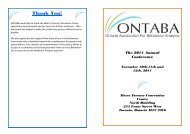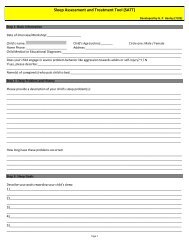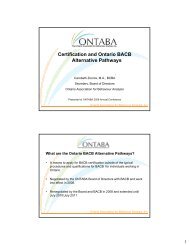Behavioural Activation & PTSD
Behavioural Activation & PTSD (pdf) - Ontaba
Behavioural Activation & PTSD (pdf) - Ontaba
- No tags were found...
Create successful ePaper yourself
Turn your PDF publications into a flip-book with our unique Google optimized e-Paper software.
<strong>Behavioural</strong> <strong>Activation</strong> & <strong>PTSD</strong>Wanda L. Smith, Ph.D., C.Psych.Private PracticeMcMaster University, Hamilton
Agenda Defining features of <strong>PTSD</strong>, co-morbidity Military related <strong>PTSD</strong> Introduce Cases Clinical treatments – PE and CPT Behaviour <strong>Activation</strong> ACT - Experiential avoidance & values
Posttraumatic Stress DisorderDSM-IVIV-TR diagnostic criteria: Exposure to a traumatic event… Response of intense fear or helplessness… Symptoms: Re-experiencingexperiencing Avoidance Arousal Duration > 1 month Significant impairment in functioning.
What makes an event traumatic? If the event is unpredictable and uncontrollable And, if the event is a severe or catastrophicviolation of our fundamental beliefs andexpectations about: safety, physical integrity, trust, and justice.(Antony & Barlow, 2004)
Utoya Island – July 22.2011
Epidemiology & <strong>PTSD</strong>Exposure to traumatic events: Lifetime trauma exposure = 50–60% (USA) <strong>PTSD</strong> prevalence = 7.8% Dose-response relationship, i.e., in countrieswhere exposure is higher, prevalence is higher.(Kessler et al, 1995)
Development of <strong>PTSD</strong><strong>PTSD</strong> may be a failure to recover.Vulnerability – risk factors: History Severity of traumatic event Peri-traumatic experiences Post traumatic factors<strong>PTSD</strong> persists without treatment…………
<strong>PTSD</strong> plus…. <strong>PTSD</strong> shows the most severe and diversepattern of co-morbidity. Individuals with a current diagnosis of <strong>PTSD</strong>,92% met criteria for another current Axis 1disorder: Depressive Disorder - 77% Substance abuse & dependence - 31% Generalised anxiety disorder - 38%Brown et al (2001)
Canadian War Experience Afghanistan:38,558 served UN & NATO: >125,000 peacekeepers Korean War (1950-1953): 1953): 26,791 served; 12,000surviving, mean age=78y. WWII (1939-1945): 1945): 1 m served; 143,700surviving, mean age=87y. WWI (1914-1918): 1918): 650,000 served, no survivingveterans.
Military Contribution to Canada’sInternational Agenda1980 – 1989Post 1990Indicates Countries where the Canadian Forces have beeninvolved
Predictors of “Probable” <strong>PTSD</strong> inMilitary/VeteransNumber of deploymentsBeing seriously woundedYounger ageNumber of life stressor (pre and post deployment)Greater current stressBiological markers (Pre-existing existing high glucocorticoid receptors)Hoge et al.,2004, Statistics Canada, 2002; Richardson et al.., 2010, Richardson et al., 2006; Pietrzak et al, 2011;Zuiden et al., 2010; Polusny et al., 2011) 12
Anger and Military-related AngerMilitary training & deployment experiences set individualsapart from others.Fear of anger - “loosing it”, “going bolistic”The association between anger and combat-related <strong>PTSD</strong> is asignificant clinical and social concern. (Novaco et al, 2002; Forbeset al., 2002, NC<strong>PTSD</strong>, 2008)“The problem most frequently reported by veterans withcombat-related <strong>PTSD</strong>, their spouses, and assessing clinicians”(Biddle, et al., 2002)Lower anger levels were associated with better outcomes(Forbes et al., 2005)
Psychiatric Disorders intreatment-seeking veterans100Figure 1. Frequencies of self-reported probable psychiatric disorders and suicidal ideation90807073.670.864.1%6050464032.43020100<strong>PTSD</strong> MDD GAD Alcohol use disorder Suicidal ideation(several days ormore)Richardson et al., 2012
<strong>PTSD</strong> Rates in CF-Afghanistan WarCumulative Incidence of <strong>PTSD</strong> and Other Mental Disorders in Canadian Forces Personnel Deployed in Support of the Mission in Afghanistan, 2001– 2008. Directorate of Mental Health-Canadian Forces Health Services Group Headquarters, November, 2011
What is a common clinical presentation?<strong>PTSD</strong>ComorbiditySpectrumMajor depressionSubstance abuseOther anxiety disorderPsychotic symptomsmTBI & Physical injuryChronic painPersonality disorder/traitsOther social dysfunctions19
Afghanistan - 2006
Co-Morbidity- <strong>PTSD</strong> plus…. Depression, with suicidal ideation Substance abuse & dependence Panic attacks, Agoraphobia, Social anxiety, OCD Chronic Pain ANGER & hostility, excessive Feelings of mistrust & betrayal Feelings of guilt, shame and disgust, intense Interpersonal relationships impaired, marital distress Work performance, poor or unable to workadapted from Leahy & Holland (2000)
Basic principles of treatment1Stabilisation2Traumafocusedpsychotherapy3RehabilitationReintegration
1 – StabilisationPsychoeducationGOALImprove currentfunctioningEstablish atrustingrelationshipAssess and treatco-morbiditiesTeach problemsolving strategies
Therapeutic RelationshipPsychotherapy requires a sound therapeutic alliance.Warmth, empathy, caring, genuine regard & competence are critical. Building trust & rapport starts in the 1 st session.J. Beck (1995, 2005)
Therapeutic relationshipEmbracing the least judgmental conceptualization of patient behavior is animportant strategy for facilitating the therapeutic relationship and developinga positive view of your patients.Linehan, , 1993
Therapeutic RelationshipCompassion, acceptance, empathy, respect & the ability to staypsychologically present even in the midst of strong emotions.Therapeutic relationships are strong, open, accepting, mutual,respectful and loving, i.e., relationships are intense, personaland meaningful.Boundaries are natural, non-arbitrary and linked to workability.Hayes, Strosahl & Wilson (1999)
Psychological Treatment of <strong>PTSD</strong>
CBT Treatments for <strong>PTSD</strong>Core components: Psychoeducation – information about the cognitivebehavioural formulation of <strong>PTSD</strong>. Exposure - prolonged exposure (Foa(& Rohbaum,1998). Cognitive restructuring – cognitive processing therapy(Resick& Schnicke, , 1993).
Exposure Therapy Set of techniques designed to help clients confront theirfeared object, situation, memories &/or images. Goalis reduction of avoidance & the promotion of mastery. Exposure: Graduated exposure Imaginal exposure to trauma memory & related cues In vivo exposure to avoided situations. Prolonged exposure: Prolonged, repeated exposure to trauma memory. Repeated in vivo exposure to situations avoided.
Cognitive Processing Therapy Focuses on appraisal of traumatic event andemotions resulting from event Involves writing narratives targeting theprocessing of guilt and shame. Goal - refrain from assimilation and assist inaccomodation w/o overaccomodation.
Research findings for CBT & <strong>PTSD</strong>For a variety of trauma populations including childhood abuse, sexualassault, MVA, veterans, CBT consisting of some form of exposureand/or cognitive restructuring, appears to be more effective thanno treatment or supportive counseling.No clear evidence that any form of CBT is superior to otherforms.CBT that includes exposure has amassed the greatest amount ofempirical support.Exposure is the cornerstone of treatment for <strong>PTSD</strong> & shouldform the basis for all treatment protocols.
But……………………………….
Treatment Resistance/FailureDespite the progress that has been achieved in the treatment of<strong>PTSD</strong>, many patients do not benefit from the first line oftreatment. The phenomenon of treatment resistance has beenparticularly noted among Vietnam veterans…but other traumapopulations have their share of treatment failures.Foa, , Keane, Friedman & Cohen (2009) p18
Functional Analysis of Depression
Depression, like infantile autism (Ferster(Ferster, , 1961),appears to be an especially appropriate field for thebehavioral psychologist because of the missing itemsof behavior that are so prominent.Ferster, , C.B. (1973) A functional analysis of depression. AmericanPsychologist, oct, , 857-870.870.
The depressed person engages in a high frequency ofavoidance and escape from aversive stimuli…along withthe reduced frequency of positively reinforced behavior.Ferster (1973)
Behaviour Therapy<strong>Behavioural</strong> Model postulates : Depression does not live inside a person, rather,depression is a problem between a person &their life. Depression results from too few pleasant & toomany negative person-environmentalenvironmentalinteractions.Ferster (1973); Lewinsohn (1974)
<strong>Behavioural</strong> <strong>Activation</strong>
<strong>Behavioural</strong> activation is a brief structuredtreatment for depression that aims toactivate clients in specific ways that willincrease rewarding experiences in theirlives.Martell, Dimidjian & Herman-Dunn (2010)
Empirical support for BA
Jacobson el al (1996) A component analysis of cognitive-behaviortherapy for depression. Journal of Consulting & ClinicalPsychology, 64(2), 295-304.150 SsExamined BA (WAS) vs BA & CT (at) vs BA & CT (at & corebeliefs).Results showed no differences in treatments – acute or at 2 yearfollow-up.
<strong>Behavioural</strong> <strong>Activation</strong> Books
10 Core Principles of BA1. Key to changing how people feel is helping themchange what they do.2. Life changes can lead to depression, short termcoping strategies may keep people stuck.3. Clues to figuring out what will be antidepressant lie inwhat precedes and follows client’s s importantbehaviours.4. Structure & schedule activities that follow a plan, nota mood.5. Change will be easier when starting small.
10 Core Principles of BA6. Emphasise activities that are naturally reinforcing.7. Act as a coach.8. Emphasise a problem solving empirical approach &recognise that all results are useful.9. Don’t t just talk, do!10. Troubleshoot possible & actual barriers toactivation.
BA Protocol Psychoeducation – the impact of <strong>PTSD</strong> &depressive symptoms on Quality of Life. ID treatment goals. Conduct functional analysis of avoidancebehaviours to identify barriers to activity. Activity scheduling - Institute weekly goalsetting & problem solving to promote successivesteps toward activation. Monitor/track engagement and mood.
<strong>Behavioural</strong> <strong>Activation</strong> and <strong>PTSD</strong>
Is BA = in vivo exposure?BA: Activities are chosen for their value notrelationship to trauma. Activities which are naturally reinforcing arechosen.
Acceptance & Commitment Therapy ACT is a behaviourally based intervention designed totarget & reduce experiential avoidance & cognitiveentanglement while encouraging clients to make life-enhancing behavioural changes which are in accordwith their personal values. Building empirical support for ACT – 56 RCT’s &recognised for treatment of depression, chronic pain &substance abuse.Hayes et al, 1999, 2005, 2007
Experiential Avoidance & <strong>PTSD</strong> Experiential avoidance - efforts made to change,eliminate &/or avoid negative internal experiences suchas thoughts, emotions, memories & sensations, with<strong>PTSD</strong>, that remind the individual of the trauma. <strong>PTSD</strong> includes avoidance of internal experiences &avoidance of places or things that remind the individualof the trauma that may cue the internal experiences. EA may be the key mechanism in the development &maintenance of <strong>PTSD</strong>.
Losing Contact with the presentExperientialAvoidancePsychologicalrigidityLack of clarity ofvalues and losing asense of direction inlifeFusionFeeling stuck andunable to live ameaningful lifeConceptual Self
The Target of ACTTo make experiential contact with previouslyavoided private events without excessive verbalinvolvement and control – and to makepowerful life enhancing choices.
Living in the presentAcceptanceChoosing a valueddirection in lifePsychologicalFlexibilityDefusionCommitment to live alife with meaningaccording to chosenvaluesSelf as the Context
Valuing – Key Points All ACT techniques are eventually subordinated tohelping the client live in accordance with his/herchosen values. Helping the client identify valued life goals &implement them in the face of emotional obstacles bothdirects & dignifies ACT. Values cannot be fully satisfied, permanently achievedor held like an object Values will never be finished Values are a direction………………..
Questions, Comments……Wanda L. Smithsmithwa@mcmaster.ca








